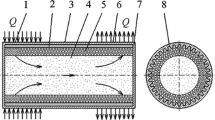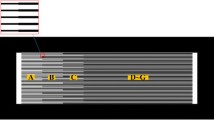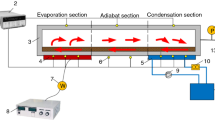Abstract
Since heat flux increases sharply yet cooling space in microelectronic and chemical products gradually decreases, a micro heat pipe has been an ideal device for heat transfer for high heat-flux products, and its performance depends largely on its capillary limit. This study proposed an integrated utilization of the advantages of lower backflow resistance to working fluid in trapezium-grooved-wick micro heat pipes and greater capillary force in sintered-wick micro heat pipes; first the factors that are crucial to both types’ heat transfer performances were analyzed, and then mathematical modeling was built for capillary limit of a micro heat pipe with the compound structure of sintered wick on trapezium-grooved substrate, and finally heat transfer limits for micro heat pipes with a trapezium-grooved wick, a sintered wick and with a compound structure were tested through experiments. Both the theoretical analysis and experimental results show that for a micro heat pipe with proposed compound structure, its capillary limit is superior to that of a micro heat pipe with a simplex sintered wick or trapezium-grooved wick.










Similar content being viewed by others
References
Chen D (2005) New technologies of electronics cooling[J]. Chin J Low Temp Phys 27(8):255–262 (in Chinese)
Gu Z (1994) Reliability theory and practice of computer[M]. University of Electronic Science and Technology Press, Chengdu (in Chinese)
Vasiliev LL (2006) Micro and miniature heat pipes—electronic component coolers. Appl Therm Eng 33(8):105–113
Zhuang J, Zhang H (2000) Technology and application of heat pipe[M]. Chemical Industry Press, Beijing, pp 25–78 (in Chinese)
Kim SJ, Seo JK, Do KH (2003) Analytical and experimental investigation on the operational characteristics and the thermal optimization of a miniature heat pipe with a grooved wick structure. Int J Heat Mass Transf 46(11):2051–2063
Launay S, Sartre V, Mantelli MBJ et al (2004) Investigation of a wire plate micro heat pipe array. Int J Thermal Sci 43(5):499–507
Launay S, Sartre V, Lallemand M (2004) Experimental study on silicon micro-heat pipe arrays. Appl Therm Eng 24(2–3):2331243
Kang SW, Tsai SH, Chen HC (2002) Fabrication and test of radial grooved micro heat pipes. Appl Therm Eng 22(14):1559–1568
Rojas ME, Andres MC (2006) Theoretical and experimental study of two-phase flow in micro-channels grooved into horizontal pipes. Int J Multiph Flow 32(4):5171526
Nilson RH, Tchikanda SW, Griffiths SK et al (2006) Steady evaporating flow in rectangular microchannels. Int J Heat Mass Transf 49(9–10):1603–1618
Li Y (2008) Study on forming mechanism of axial micro grooves inside copper heat pipe via high-speed ball-spinning. Ph.D thesis. South China University of Technology Guangzhou, China
Li X (2009) Study on manufacturing method and heat transfer capability of micro heat pipe with sintered wick. Ph.D thesis. South China University of Technology Guangzhou, China
Lu L (2009) Formation mechanism study of grooved wicks with porous layer applied in tubular vapor chamber. Ph.D thesis. South China University of Technology Guangzhou, China
Chi Y. (2007) Design, fabrication, testing and analysis of high performance miniaturized capillary pumped loops. Ph.D thesis. South China University of Technology Guangzhou, China
Acknowledgments
This project supported by National Natural Science Foundation of China (51075218), Natural Science Foundation of Heilongjiang Province of China (E200909) and Hei Long Jiang Postdoctoral Foundation (LBH-Z10006).
Author information
Authors and Affiliations
Corresponding author
Rights and permissions
About this article
Cite this article
Li, X., Wang, J., Hu, Q. et al. Experimental and theoretical research on capillary limit of micro heat pipe with compound structure of sintered wick on trapezium-grooved substrate. Heat Mass Transfer 49, 381–389 (2013). https://doi.org/10.1007/s00231-012-1090-y
Received:
Accepted:
Published:
Issue Date:
DOI: https://doi.org/10.1007/s00231-012-1090-y




